The anechoic chamber at Orfield Laboratories in Minneapolis is the “quietest place on Earth”. A room so terrifyingly silent it can drive occupants to the brink of madness. In this Minnesotan facility – used for all from testing dishwasher volumes to training astronauts to cope with the frightening noiselessness of space – boffins have taken the quest for a moment’s peace to bonkers levels.
In a steel box suspended by springs inside foot-thick concrete walls, there exists a void that kills soundwaves as effectively as Mr Muscle does kitchen germs (99.9% of them).
At latest world-record-breaking rating in 2021, it measured a whopping -24.9 decibels. It’s so supersonically silent that people who spend time within report hearing the sounds of their own bodies – the thumping of their hearts, the rush of blood through veins. They can hear themselves blink. Within as little as 15 minutes some have reported claustrophobia, nausea and panic attacks.
The soundtrack of our mortality may be too much to bear. I have no desire to be driven insane by my gurgling guts. I just mention this because I feel the anechoic chamber is a handy device for making a point about music, and our growing societal obsession with surrounding ourselves with it, day in, day out.
Get the latest news and insight into how the Big Issue magazine is made by signing up for the Inside Big Issue newsletter
In our pinging, bleeping, blipping, babbling, droning, ring-toning, air-podding, always-on world, are we now scared to be alone with our own silence? Are we trying to block out the terrifying fact of our existence? Or are cynical corporate forces intent on constantly pumping crummy content into our brains at it again? Let me briefly make the case for switching off once in a while.





